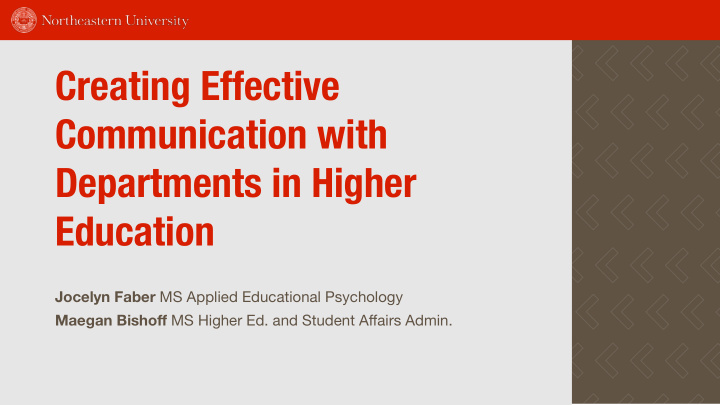



Creating Effective Communication with Departments in Higher Education Jocelyn Faber MS Applied Educational Psychology Maegan Bishoff MS Higher Ed. and Student Affairs Admin.
Setting the Expectations… § Learn useful techniques and strategies to keep communication lines flowing § Gain confidence to discuss positive and negative feedback with departments § Learn how to set and manage role expectations as an advisor
What makes us so special?
What makes us so special?
Background about Northeastern University § Large Private Research-based Institution § 17,506 Undergrad § 175 majors § 8 colleges within University § College of Art, Media, & Design (CAMD)
Advising Before & After § College of Art, Media, & Design § 1,540 students; 300:1 student advisor ratio § Faculty Advising to Professional Advising § Advisors cover academic planning and administrative duties § Department chairs make program substitutions and changes § Advisor autonomy and inclusion in department discussions § Siloes in budget, policy, and academically
Flow of Communication in Higher Ed. Academic Advisor Student Department Chair Key Faculty Dean’s Office Parents
Common Sources of Miscommunication § Curriculum changes § Adding a new class § Changing major requirements § Course substitutions § Adding new majors/minors to a department
Common Sources of Miscommunication § Role Confusion § Duplicating efforts § Staff changes § Class Cancelations § Department having trouble letting go of control
Common Sources of Miscommunication § Improper Referrals § Complete Avoidance
Impediments of Miscommunication § Historical § Structural § Cultural § Generational
Impacts of poor communication?
Fixing the Problem: Starting at the Core § Know yours and your departments Communication Styles § Carl Jung’s Types of Communication Styles: § Controller § Collaborator § Analyzer § Socializer
Fixing the Problem: Reaching a Solution § John Dewey’s Reflective Thinking Sequence § Define the problem § Analyze the problem § Establish criteria for a solution § Generate possible solutions § Select the best solution
Fixing the Problem: Expanding the Solution § Salem & Gratz’s Organizational Communication Theory in Higher Ed § Concentrate on a situation’s description § Obtaining agreement on the status quo § Focus on goal creation and group consensus of those goals § Consider alternative courses of action
Fixing the Problem: More Considerations § Generational and cultural aspects § Work to change the campus culture and expectations campus wide
Tips for Effective Communication § Start from the top § College mission § Dean buy-in § Know and keep the flow of communication § Don’t dwell on negatives or past issues and show appreciation
Tips for Effective Communication § Departments: § Create a handbook § Process documentation § Defer to department’s preferred form of communication § Utilize liaisons § Volunteer to teach class or speak within a department § Frequent check-Ins
Case Studies
Coming Together § Future assessments § Focus groups § Surveys § Other ideas?
Questions?
Recommend
More recommend